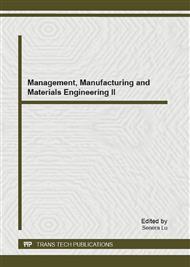[1]
Islam T & Meade N. (1997). The diffusion of successive generation of a technology; a more general model. Technological Forecasting and SocialChange, 56, 49-60.
DOI: 10.1016/s0040-1625(97)00030-9
Google Scholar
[2]
Danaher P J, Hardie B G S & Putsis W P, Jr. (2001). Marketing-mix variables and the diffusion of successive generations of a technology innovation. Journal of Marketing Research, 501-514.
DOI: 10.1509/jmkr.38.4.501.18907
Google Scholar
[3]
Yufang zhong, Innovation Diffusion Model for Productswith Multiple Technological Generations[J], Value Engineering, 2008, 11: 46-48.
Google Scholar
[4]
Yinghui yang, Chunyou wu, The Application For A Diffusion Theory of Adoption and Substitution for Successive Generations with Norton Model[J], Studies in Science of Science, 2005, 5: 682-687.
Google Scholar
[5]
Peter J. Danaher, Bruce G.S. Hardie, and William P. Putsis Jr, Marketing-Mix Variables and the Diffusion of Successive Generations of a Technological Innovation, Journal of Marketing Research, Vol. XXXVⅢ{TTP}8546 (November 2001), 501-514.
DOI: 10.1509/jmkr.38.4.501.18907
Google Scholar
[6]
Bass, Frank M. A New Product Growth Model for Consumer Durable[J]. Management Science, 1969, 15: 215-227.
Google Scholar
[7]
Norton, J.A. And Bass F.M. A Diffusion Theory Model of Adoption and Substitution for Successive Generations of High-Technology Products[J], Management Science, 1987, 33: 1069-1086.
DOI: 10.1287/mnsc.33.9.1069
Google Scholar
[8]
Rajkumar Venkatesan ,V. Kumar, A Genetic Algorithms Approach to Growth Phase Forecasting of Wireless Subscribers[J], International Journal of Forecasting [J], 2002, 18: 625-646.
DOI: 10.1016/s0169-2070(02)00070-5
Google Scholar
[9]
Rajkumar Venkatesan, Trichy V. Krishnan, V. Kumar, Evolutionary Estimation of Macro-Level Diffusion Models Using Genetic Algorithms: An Alternative to Nonlinear Least Squares, Marketing Science, 2004 (23)451-464.
DOI: 10.1287/mksc.1040.0056
Google Scholar
[10]
Schmittlein ,D.C. and V. Mahajan, Maximum Likelihood Estimation for An Innovation Diffusion model of New Product Acceptance, Marketing Science. 1982, 1: 57-78.
DOI: 10.1287/mksc.1.1.57
Google Scholar
[11]
Srinivasan,V. and Mason,C. H . Nonlinear Least Squares Estimation of New Product Diffusion Models, Marketing Science, Vol. 5, No. 1, Winter, (1986).
DOI: 10.1287/mksc.5.2.169
Google Scholar
[12]
Putsis .W. P . and V. Srinivasan, Estimation Techniques for Macro Diffusion Models[M]. New-Product Diffusion Models. Kluwer Academid Publishers. Dordrecht. pp.264-291.
Google Scholar


